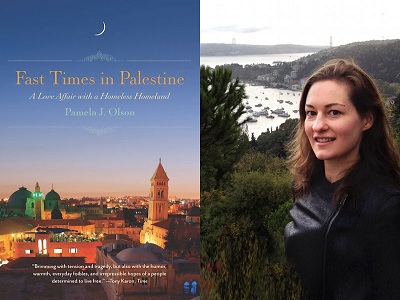
Reviewed by Jamal Kanj
(Fast Times in Palestine. Pamela Olson. Seal Press, March 2013)
Whenever I read a biographical book, I make it a point to start with the acknowledgement page to learn a little about the writer. In reading “Fast Times in Palestine: A love affair with a homeless homeland,” I had to start from the end of the book.
In those two pages the author thanked more than fifty individuals, but what got my attention was recognizing her ninth grade teacher for forcing her to write “a journal every day.” A gift the author displayed meticulously in chronicling the places and people she met in every page of a moving memoir of her journey in Palestine.
As I read the book I tried to fathom what drove a young American woman from a small town in Oklahoma with degree in physics to end up spending two years traversing military checkpoints and helping farmers harvest olives in the Middle East.
It could have been her adventurous nature and love for travel that brought her to that part of the world, but it was sheer destiny that tossed her into the abyss of fire to tell the world of her “love affair with a homeless homeland.”
After graduating from Stanford University in 2002, the newly graduated student was working at a neighborhood bar to save enough money for a backpacker vacation in the Greek isles when her French friend suggested Egypt as an alternative, less expensive destination. She traveled to Cairo and the Sinai, where she met an Israeli tourist named Dan who invited her to visit him in Israel.
Her journey took her across the Red Sea to Jordan, where she met—by chance—two peace volunteers, one British and one Canadian, who were on holiday from their work in Palestine. In the few days she spent with them in a downtown Amman hotel, she learned for the first time of the $3 billion the US government pays Israel annually on behalf of American taxpayers.
Stories about occupation, the Palestinian people and human rights activism intrigued her, and she became interested in finding out for herself the truth about life in the West Bank. She jumped on the opportunity when they invited her to come along with them, and they took her to an unlikely tourist destination, a small Palestinian village called Jayyous.
The author tackles the paradox of occupation in very straightforward layman’s terms, describing how a forty-mile journey from Jerusalem to the Palestinian city of Nablus would take a full day crossing a separation wall, changing cabs six times and navigating permanent and flying Israeli military checkpoints. Meanwhile a much longer trip with her Israeli friend on “Jewish only settlement roads” could be completed uninterrupted in a much shorter time.
She also describes how the separation wall isolates villagers from their olive groves and farms—for many their only livelihood—while hilltop Jewish-only settlements encroach on centuries-old trees and isolate Palestinian towns and villages into islands surrounded by Zionist colonies and the army that protects them.
Ever more fascinated by the wickedness of occupation and the joys of life among Palestinians, Pamela Olson took a low-paying job in Ramallah as an editor and head writer for the Palestine Monitor to study and document the daily human rights abuses under Israeli occupation.
Living and working in the Palestinian political capital, Pamela entered Palestinian politics from its widest doors by becoming the foreign press coordinator for a major candidate in the 2005 presidential election.
In her two years between Jayyous and Ramallah, the author takes the reader on an extraordinary expedition very few of us will ever get the opportunity to experience in a lifetime. She takes us along with her via immaculate descriptions of the spring greenery on hills and meadows—not yet raped by the concrete desertification of the Jewish only settlements—or smoking Nargila (hookah) on porches with friends in Jayyous or sipping coffee at westernized cafés in Ramallah.
What makes this book special is the writer’s ability to keep the reader spellbound with her vivid descriptions of events, people and places. The reader is able to feel the author’s inner glee meeting beloved friends, pain while witnessing and experiencing the horrors of occupation and the melancholy of bidding farewell to people who became part of her family in Palestine.
– Jamal Kanj (www.jamalkanj.com) writes weekly newspaper column and publishes on several websites on Arab world issues. He is the author of “Children of Catastrophe,” Journey from a Palestinian Refugee Camp to America. He contributed this article to PalestineChronicle.com.






I can but wonder where is Pamela Oslsen now, and does she remain garlanded in faded print dress and strawbonnet shading rost oloured specs. Or is she simply apolitical and has neither the knowledge or the interest to equally inform the reader of the myriad of ways a largely passive Palestinian populace collude in their own occupation, and witlessly support a leadersship that is the second highest paid in the world, in return for even more Occupation- which is still possible.
In this very powerful book, Pamela Olson manages magic and beauty while reporting the unfortunate facts with precision as her copious and interesting footnotes attest. Those who think themselves well-informed on the Palestinian/Israeli problem are in for a shocked awakening, for Olson very deftly brings the conflict right to our doorstep, right into our hearts and minds. What is unfortunate is that our media refuses to bring us this news openly and truthfully, and that is why “Fast Times in Palestine” should have a place in every classroom in the world, and should be mandatory reading! We are waiting anxiously for her follow-up book! Kudos to Seal Press for publishing this great book!